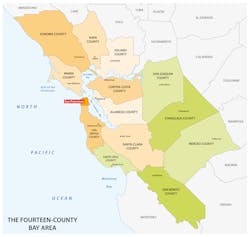Researchers at the University of California San Francisco (UCSF) are linking public data sets with electronic health record data to help healthcare systems collaborate and embark upon place-based interventions to increase public health improvements.
In a recent presentation at the WEDI Quest for Health Equity conference, Courtney Lyles, Ph.D., associate professor in UCSF’s Division of General Internal Medicine, began by saying that “it's pretty clear — and COVID, I would say has made it even more clear — that health is really impacted by place.” For example, In places in California’s San Joaquin Valley, different exits off the freeway have differences in years of life expectancy, she noted.
Lyles noted that other presenters at the conference had spoken about how to better screen patients for social needs and how to refer them to social resources in the community. “I'm going to push a little further on a third strategy that's using publicly available place data to augment or target the way in which we deliver health and healthcare services to the places that have the highest need,” she said.
UCSF has put together an interactive website called the Health Atlas. It maps 100 social determinants of health variables, at various levels of granularity from a geospatial lens throughout California. “We were working on this interactive website from a population health and health equity landscape prior to COVID,” Lyles explained, “but we decided, right around this time last year, when things started to pick up on the COVID cases that we would augment this interactive website with COVID cases on top of some of the health and health equity variables that we had already been compiling. And so for California it has real-time data on COVID cases, deaths, hospitalization rates, and new variables about COVID in nursing homes and prisons in California.”
She said that in choosing which data to include, they relied heavily on the Healthy People 2020 social determinants of health framework to think through mapping out demographic characteristics, economic factors, community and neighborhood characteristics, and health and healthcare indicators.
For instance, she showed a map with Spanish speakers across California at the county level. “We thought a lot about things like that at the community level in terms of language. We also have variables that are related to communities such as like population density, people living in households with children versus single adult household, and seniors living alone. There is also a lot of publicly available data about environmental health risk, down to granular neighborhood levels in California. Thinking about those variables has really been interesting to think through what matters for population health and health equity risk.”
She then showed how COVID data can be overlaid on top of all of the other domains and variables. Lyles said this can be valuable as the California Department of Public Health and governor’s office think about using data as a way to think about equity in COVID vaccine rollout and that healthcare systems are tracking the same kinds of variables.
Lyles described another example of how the Health Atlas is being used to link place-based data to variables in their electronic health record data to think differently about interventions to deal with disparities in hypertension outcomes. Once they had patient addresses geocoded and linked out to census tracts, they added clinical and demographic data for patients with hypertension within their system and partnered with the Office of Population Health to do an analysis to better target their outreach efforts.
“I don't think these data are showing us something that we didn't know already about structural disparities and care or structural disparities in our in our society,” Lyles said, “but they are using real-time electronic health record data to show that within our delivery system place is something that we should be thinking about. While our healthcare systems are located in certain neighborhoods, maybe place-based strategies need to be a part of our disparities programs for our quality improvement programs for blood pressure control. When you look at the map and you put it out there in a visual display, it actually gives you more impetus to think about neighborhoods you might want to target or thinking differently about what you might be doing about your intervention moving forward.”
She said there are multiple value propositions for thinking about contextual place-based data. “We are sitting on a wealth of data within our electronic health records to help rethink how we engage in population health,” Lyles added. “Public health leaders have been thinking about place for a really long time. It's probably a little newer in the healthcare provider space to think about investing in housing or food in a different way. But we probably need to be blurring the lines even further between healthcare and public health if we really want to do things differently, and to think about place as a driver of disparities and to achieve equity.”
“The more we put the onus on delivery systems for true value-based care and population health management, the more we're going to have to be in this public health space, because many of the reasons why we're thinking about quality indicators or outcomes are the conditions in which people live and work and play every day," she added. "And we have to account for that in healthcare systems if we really want to make a dent in equity.”
Lyles said UCSF is thinking about external partnerships as well. They have been partnering with the San Francisco Department of Public Health to think about chronic disease in a different way in a program called Partnership for Healthy Cities. “We've been thinking a lot about how can we get our UCSF health data linked to other electronic health record data on chronic disease like hypertension and other priority conditions,” she said. “We have been having conversations, mostly brokered by our Department of Public Health, on how the Department of Public Health can be an honest broker between organizations such as Sutter, Dignity and Kaiser that are thinking about these programs, but which we've all sort of been doing independently. We’re trying to think about bringing together data in a way that would serve our communities more effectively.”


